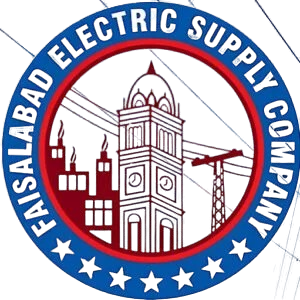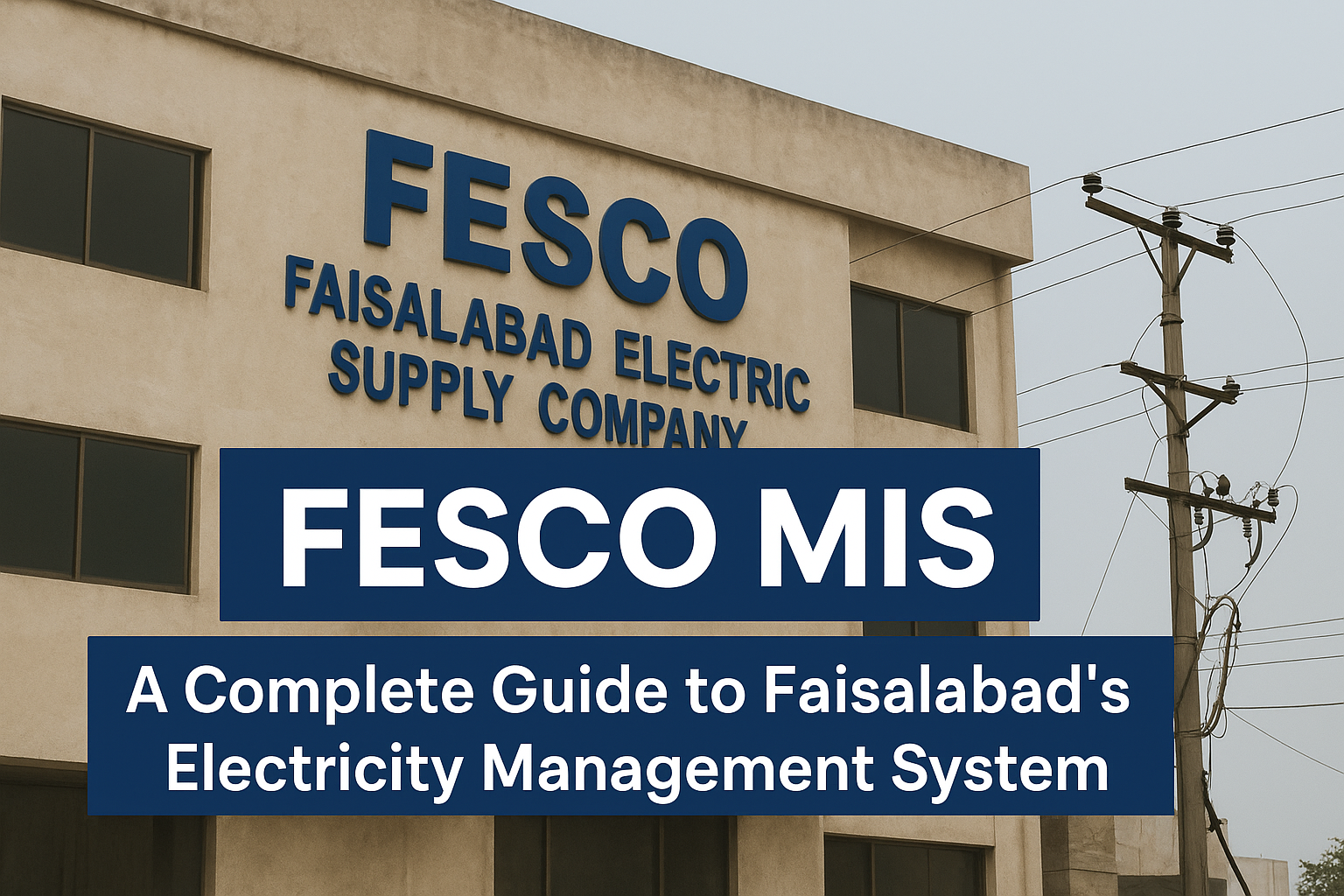FESCO MIS (Management Information System) is the digital backbone used by Faisalabad Electric Supply Company to manage consumer services, outage and shutdown schedules, complaint tracking, new connections, feeder details, and billing information. Consumers can view bills, lodge and track complaints through the CCMS portal or FESCO’s e-services and apps, and check planned shutdowns by feeder. FESCO MIS
Electricity runs our lives — from the chai kettle in the morning to the factory lines humming through the night. In Faisalabad and the surrounding districts, FESCO (Faisalabad Electric Supply Company) is the organisation responsible for getting that power to homes, shops, and industries. Over the last decade, FESCO has moved many of its public-facing operations onto digital platforms. Collectively these platforms, portals and apps make up what most people call FESCO MIS — the Management Information System that powers customer services, operations data, and outage tracking.FESCO MIS
This guide walks you through everything a citizen, small business owner, or local blogger needs to know about FESCO MIS: what it is, how to use it, why it matters, and real-world tips that actually save time and stress.FESCO MIS
Table of contents
- What is FESCO MIS?
- Why FESCO MIS matters to consumers and businesses
- Main components of FESCO MIS (portals & apps)
- CCMS (Customer Complaint Management System)
- e-Services & Online Bill Systems
- ENC (Electricity New Connection) Portal
- Shutdown / Load Management Schedules & Feeder Details
- Mobile apps (FESCO Light / consumer facilitation)
- How to use FESCO MIS: step-by-step tasks
- Check or download your bill
- Lodge and track a complaint (with screenshots of the process described)
- Find outage or shutdown schedules by feeder
- Apply for a new connection (ENC)
- Behind the scenes: how MIS helps operations (SCADA, feeders, crew dispatch)
- Common problems and how to solve them (billing disputes, no-supply issues, delayed complaints)
- Tips, tricks, and real-life examples to get faster results
- What’s next: modernization, smart meters and expectations for consumers
- Quick FAQ (featured-snippet friendly answers)
- Resources & official links
What is FESCO MIS?
FESCO MIS is the collective set of digital systems the company uses to manage customer data, outages, meter reading, billing, complaint handling, new connections, and operational schedules. For customers, the most visible parts are the online bill portal, the Customer Complaint Management System (CCMS), the ENC portal for new connections, and the shutdown/feeder information pages. The official FESCO website and e-services pages host many of these functions.
Why FESCO MIS matters to consumers and businesses
A reliable MIS delivers two things: information and action.
- Information: accurate bills, clear shutdown schedules, and feeder-level outage info reduce uncertainty — especially for businesses that plan production runs around power availability.
- Action: lodging a complaint should trigger a ticket, a field visit, and resolution tracking. When that chain works, lost hours (and lost rupees) are reduced. FESCO MIS
For factories in Faisalabad, an unexpected feeder trip means production delays. For a home, a missing bill means fines or late fees. FESCO’s MIS ties both sides together.
Main components of FESCO MIS (portals & apps)
Below are the parts you’ll use most often.
CCMS — Customer Complaint Management System
The CCMS is the central complaint registration and tracking portal used by FESCO customers. Through it you can register new complaints, search feeder details, track a ticket by reference number, and verify customer details. This is often the fastest way to register a no-supply or billing complaint that generates a ticket for field crews.
Why CCMS matters: it converts a phone call into a traceable ticket. That ticket has fields for feeder, crew action, timestamps, and resolution status — which managers use to measure performance.
e-Services & Online Bill Systems
FESCO’s e-services page lists online bill checking, new connection documents, forms, bill estimators, and load management information. Several third-party and bank portals (e.g., myABL, fascobill.pk, and other bill-view sites) let you check and pay your 14-digit reference number bill online.
Key consumer actions here: view current bill, download PDF bill, and pay online.
ENC — Electricity New Connection Portal
The ENC (Electricity New Connection) portal allows applications for new connections online, including cost calculators, downloadable SOPs, and officer workflows for field verification. It reduces the need for multiple trips to office counters.
Shutdown / Load Management Schedules & Feeder Details
Planned maintenance and shutdowns are published by feeder on dedicated MIS pages. Consumers can search by feeder or grid station to see scheduled outages (important for industrial scheduling). FESCO maintains a shutdown schedule page and also publishes notices for annual maintenance and emergency restorative actions.
Mobile apps (FESCO Light / consumer facilitation)
Mobile apps like FESCO Light let consumers access billing, lodge complaints, and view load management schedules from Android devices. Updated apps are increasingly used to reduce call center load and give consumers immediate ticket status.
How to use FESCO MIS: step-by-step
I’ll walk you through the most common tasks with practical steps you can follow right now.
1) Check or download your FESCO bill
- Find your 14-digit reference number on any previous bill (top of the bill).
- Visit FESCO’s official e-services page or a trusted bill-check site (banks and recognized portals work too).
- Enter the 14-digit number and view/download the PDF bill. You can also note the due date and KWh consumption.
Pro tip: If you don’t have a reference number, CCMS can often retrieve your account with your mobile number or CNIC.
2) Lodge and track a complaint (no supply / voltage / billing)
- Go to the CCMS portal (Customer Complaint Management System).
- Choose “Register Complaint” and fill in the details: reference number (or mobile), complaint type (no supply, low voltage, billing, theft), and a short description.
- Submit and note the ticket/reference number you receive.
- Use “Track by Reference” to check updates. Field engineer arrival, crew action, and resolution are usually recorded here.
Real-life example: A Karachi-based textile unit reported repeated sudden trippings. After registering a CCMS ticket and uploading photos of the damaged wiring, crew visited within a day and replaced faulty isolators — CCMS ticket recorded turnaround time and reduced future downtime.
3) Find outage or shutdown schedules by feeder
- Visit the FESCO shutdown/schedule page.
- Search by feeder name or browse grid station lists. The schedule lists planned maintenance with dates and timing.
- For unplanned outages, CCMS or the outage map (if available) is the go-to.
Note: Planned shutdowns are sometimes adjusted — always check the page close to the date.
4) Apply for a new connection (ENC)
- Use the ENC portal to fill the application and upload required documents (CNIC, NOC if required, site photo).
- Pay any applicable processing fees as instructed.
- Track the application through the ENC dashboard or by contacting the focal person mentioned in the portal.
Behind the scenes: how MIS helps operations
FESCO’s MIS is not just for customers — it’s integral to daily operations:
- Feeder monitoring (SCADA): Supervisory Control and Data Acquisition integrates data from substations and feeders for remote monitoring. When a feeder trips, SCADA helps identify whether the fault is upstream or local. MIS and SCADA together guide crew dispatch.
- Crew scheduling: Tickets from CCMS feed into field dispatch dashboards so the nearest crew is assigned. This reduces response time and avoids duplicate visits.
- Load management: During high-demand periods, MIS indicates feeders for load management rotation (scheduled load-shedding), which is then shared with the public through the shutdown schedules.
Common problems and how to solve them
Problem: I didn’t receive a physical bill
Solution: Check online with your 14-digit reference or through bank portals. If the bill shows unpaid and the due date is close, print and pay online to avoid penalties. If the bill is missing due to meter reading errors, register a bill correction complaint via CCMS.
Problem: Frequent short outages / low voltage
Solution: Register a “low voltage / supply fluctuation” ticket in CCMS and, if possible, attach a short video showing dimming. Persistent low voltage often requires feeder or line inspection and sometimes transformer replacement.
Problem: Billing spike / estimated bill
Solution: Lodge a “billing dispute” ticket in CCMS and ask for an actual meter reading check. If your meter is faulty, request meter testing through the official e-services or customer center.
Problem: Complaint not resolved or long delays
Solution: Note the reference number and escalate: use FESCO customer service numbers, visit the complaint management cell page, or follow up at your local FESCO office. Document dates and ticket numbers — escalation works better with records.
Tips, tricks, and real-life examples to get faster results
- Always keep the reference number: When you call or follow up in-person, the 14-digit reference and CCMS ticket number are the fastest ways to get information.
- Use the mobile app for quick updates: FESCO Light and other consumer facilitation apps provide push updates and are faster than email.
- Photos and short videos help: When you report a pole fire, sparking, or damaged transformer, photos speed triage and prioritization.
- Use bank/portal payments and keep receipts: Paying through official bank channels (e.g., myABL) gives a timestamped receipt — handy if the system still shows unpaid.
- When in doubt, visit your local office: For complex disputes like meter testing or reconnection after theft investigations, the in-person route still helps.
Real example: A small shop owner in Jaranwala noticed a sudden 300% bill jump. After uploading photos of the meter display and the shop’s working hours via CCMS, the meter was verified as wrongly configured and replaced — the corrected bill arrived two billing cycles later, and the merchant avoided penalties.
What’s next: modernization, smart meters and expectations
The future of any DISCO (distribution company) is digital-first operations and smart metering. Smart meters reduce estimated reads, provide near real-time consumption data, and enable time-of-use tariffs — which could help industrial consumers shift load to off-peak hours and save money.
FESCO, like other Pakistani DISCOs, has been part of broader modernization and tender activity (procurement, transformers, grid upgrades) reported publicly — an indicator that upgrades are ongoing. These projects usually show up in tender notices and NEPRA filings.
Quick FAQ (featured-snippet optimized)
Q: Where can I check my FESCO bill online?
A: Use FESCO’s e-services page or trusted bill portals—enter your 14-digit reference number to view and download a PDF bill.
Q: How do I register a complaint for no supply?
A: Register at the CCMS portal (Register Complaint), provide your reference or mobile number, select complaint type, and note the ticket number for tracking.
Q: How can I see scheduled shutdowns for my area?
A: Visit FESCO’s shutdown/schedule page and search by feeder or grid station to see planned maintenance and outages.
Q: Can I apply for a new connection online?
A: Yes — use the ENC portal to submit documents and track the application.
Credibility: sources and how they back this guide
This guide draws on FESCO’s official e-services pages, the CCMS complaint portal used across DISCOs, shutdown schedule pages hosted on FESCO’s MIS server, and documented portals/apps such as FESCO Light and bank bill-payment integrations. Official tender and regulatory notices (NEPRA) offer additional context about ongoing upgrades and the company’s scope. Key pages used: FESCO e-services and customer sections, CCMS+ complaint pages, shutdown schedule, ENC portal, and public app pages.
Resources & official links
- FESCO (official site) — e-Services and customer pages.
- CCMS (Customer Complaint Management System) — register and track complaints.
- FESCO Shutdown / Load Management schedule page.
- ENC portal for new connections.
- FESCO Light App (Android) — consumer facilitation & complaint lodging.
Closing notes — simple checklist for FESCO customers
- Keep your 14-digit reference number handy.
- Use CCMS to lodge complaints and always note the ticket number.
- Check the shutdown schedule if you need planned-maintenance info.
- Use the ENC portal for new connections and to avoid repeated trips.

